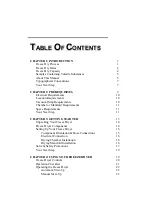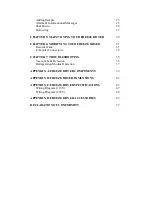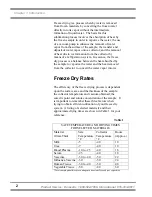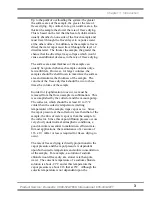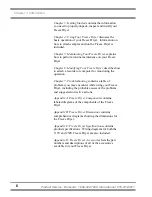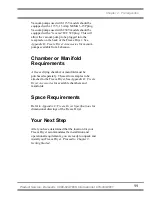
3
Product Service: Domestic 1-800-522-7658, International 816-333-8811
Chapter 1: Introduction
Up to the point of overloading the system, the greater
the surface area of the sample, the greater the rate of
freeze drying. By contrast, for a given surface area, the
thicker the sample the slower the rate of freeze drying.
This is based on the fact that the heat of sublimation is
usually absorbed on one side of the frozen sample and
must travel through the frozen layer to vaporize water
at the other surface. In addition, as the sample is freeze
dried, the water vapor must travel through the layer of
dried material. The thicker the sample, the greater the
chance that the dried layer may collapse which would
cause an additional decrease in the rate of freeze drying.
The surface area and thickness of the sample can
usually be ignored when each sample contains only a
few milliliters. However, for larger volumes, the
samples should be shell frozen to maximize the surface
area and minimize the thickness of the sample. The
volume of the freeze dry flask should be two to three
times the volume of the sample.
In order for lyophilization to occur, ice must be
removed from the frozen sample via sublimation. This
is accomplished by the collector and the vacuum pump.
The collector, which should be at least 10 to 15°C
colder than the eutectic temperature (melting
temperature) of the sample, traps vapor as ice. Since
the vapor pressure at the collector is less than that of the
sample, the flow of water vapor is from the sample to
the collector. Since this vapor diffusion process occurs
very slowly under normal atmospheric conditions, a
good vacuum is essential to maintain an efficient rate.
In most applications, the maintenance of a vacuum of
133 x 10
-3
mBar or less is required for freeze drying to
occur.
The rate of freeze drying is directly proportional to the
vapor pressure and the vapor pressure is dependent
upon both eutectic temperature and solute concentration
of the sample. For example, a solution of sodium
chloride would freeze dry at a slower rate than pure
water. The eutectic temperature of a sodium chloride
solution is about –21°C and at this temperature the
vapor pressure is about 1/16 that at 0°C. Although the
eutectic temperature is not dependent upon the
Содержание FreeZone Plus
Страница 14: ...12 Product Service Domestic 1 800 522 7658 International 816 333 8811 Chapter 2 Prerequisites...
Страница 20: ...18 Product Service Domestic 1 800 522 7658 International 816 333 8811 Chapter 3 Getting Started...
Страница 30: ...28 Product Service Domestic 1 800 522 7658 International 816 333 8811 Chapter 4 Using Your Freeze Dryer...
Страница 43: ...41 Product Service Domestic 1 800 522 7658 International 816 333 8811 Appendix A Freeze Dryer Components...
Страница 44: ...42 Product Service Domestic 1 800 522 7658 International 816 333 8811 Appendix A Freeze Dryer Components...
Страница 46: ...44 Product Service Domestic 1 800 522 7658 International 816 333 8811 Appendix B Freeze Dryer Dimensions...
Страница 58: ...56 Product Service Domestic 1 800 522 7658 International 816 333 8811 Appendix D Freeze Dryer Accessories...
Страница 59: ...57 Product Service Domestic 1 800 522 7658 International 816 333 8811...

